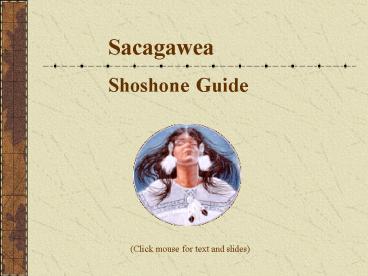Sacagawea - PowerPoint PPT Presentation
1 / 11
Title: Sacagawea
1
Sacagawea Shoshone Guide
(Click mouse for text and slides)
2
Who Am I?
I was born the daughter of a Shoshone Indian
Chief about 1790.
My name, Sacagawea, means Bird Woman
At about age ten, I was captured by Hidatsa
Indians and taken to their village on the upper
Missouri River.
When I was about sixteen years old, I was sold to
a French Canadian fur trader named Toussaint
Charbonneau, who took me as his wife.
3
Sacagaweas Journey
In 1804, explorers Lewis and Clark,
whose expedition had set out to explore lands
west of the Mississippi, engaged my
husband Charbonneau as an interpreter.
I was asked to accompany them as an interpreter
and a token of peace with Indian tribes.
I was pregnant with my first child, who was born
and named Jean Baptiste, nicknamed Pompey. I
carried Pompey on a cradleboard as the Corps of
Discovery headed upriver in 1805.
4
I was the only woman on the expedition. In
addition to being a translator, my duties were
to dig for roots, collect edible plants and pick
berries for food and medicine.
In 1805, after crossing the Continental Divide we
met a group of Shoshones. Was I surprised to see
that their chief, Chief Cameahwait, was my long
lost brother! We were able to purchase horses
needed for our trip from his tribe.
I was very helpful to the Corps as a symbol of
peace. Other Indians believed that the whites
were friendly when they saw me. A war party
would never travel with a woman and a baby.
At one point, when crossing a river, our boat
nearly capsized. I was able to help save
important papers and supplies.
5
..more about my journey..
On November 25, 1805, our expedition reached the
place where the Columbia River emptied into the
Pacific Ocean. We wintered at Fort Clatsop, a
site near present day Astoria, Oregon.
One day we were told of a stranded whale on a
beach some miles from our camp. I was allowed to
travel with the men to see the monstrous fish
and finally the great water, the Pacific Ocean!
6
Journeys End
As we journeyed back home, we once again passed
through my homeland. I was able to guide the
Corps through trails I remembered from my
childhood. I was able to lead them to the
Yellowstone River in Montana.
In May, 1805, Captain Lewis honored me by naming
a tributary of todays Musselshell River in
Montana, Sacagawea or Bird Womans River.
I returned with the Corps to the Hidatsa-Mandan
villages in August, 1806, marking the end of my
journey with Lewis and Clark. My husband,
Charbonneau, was given 500 and 320 acres of
land for his service. Being a Native American
woman, I was given nothing.
7
Sacagaweas Later Years
Six years after the expedition, I gave birth to a
daughter, Lisette. Toussaint and I were living
at Fort Manuel, a fur trading post in present day
South Dakota.
I died in December, 1812, at age twenty-five, of
a serious illness, soon after giving birth.
About a year after my death, Captain Lewis
legally adopted my two children, and took them to
St. Louis. He educated them and cared for them
there.
8
Maybe .
There is a second theory about my later years.
Some historians believe that I lived to be one
hundred years old, was known as Porivo and was
buried in Wyoming.
However, primary evidence is stronger that I died
at age twenty-five and was buried near Fort
Manuel in South Dakota.
9
Why Am I Remembered?
I was a legendary figure in the history of the
American West.
Women were not permitted to participate in
expeditions to unknown lands. I was given special
permission, as I could help with interpretation,
guiding, trading for needed goods and food
gathering.
Captain Lewis believed I could be of help and
also would be an important symbol of peace.
Tribes knew that a war party would never have a
woman along, and therefore knew we were a
peaceful expedition.
I was a rare Native American woman, to have been
a part of such a monumental expedition.
10
What Have You Learned About Me?
What is my name and what was its meaning in my
native language?
Who were the Captains of our expedition? What
was the purpose of our expedition and where were
we headed?
Can you list five things that happened to me
along the way?
Why was I allowed to go along and what was I able
to do for the Corps of Discovery?
How do you think I felt about being along on such
an exciting, but dangerous journey?
11
Sacagawea Statue, Bismark, North Dakota
Sacagawea and baby Pomp































